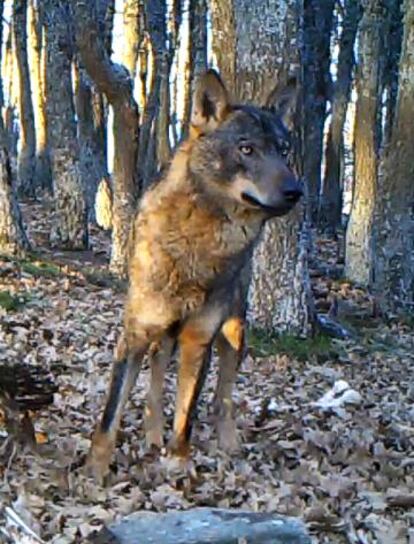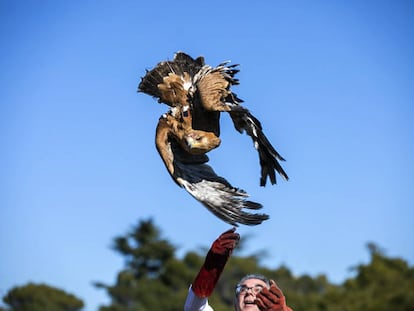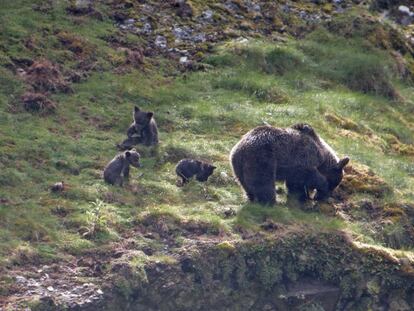Wolves make a comeback in Madrid 70 years after their disappearance
Five packs have set up home in the region but ranchers are worried about attacks on their livestock

In 2013, the Spanish conservation group Sierra Carpetania filmed two adult wolves, one young male and four wolf cubs inside the Guadarrama National Park. Wolves were once again breeding in the Madrid region after being hunted across the country and virtually disappearing for 70 years.
Now, five years after that sighting, there are “at least five established packs, and that is a conservative figure. The number of specimens ranges between 35 and 40,” says Luis del Olmo, the Madrid regional environment and sustainability chief, citing figures from the latest study commissioned by the Madrid regional government.
The study shows that the numbers are growing “slowly but surely, and are now consolidated in the region,” says Del Olmo.
Wolf expert and biologist Juan Carlos Blanco, who directed the study, says that the wolves are also moving further inland. “Before, they were on the border of the Madrid mountain range with other regions like Segovia or Ávila,” he explains. But now “they are not so close to the edge and there are other places where they are a regular presence, and where they will likely establish themselves in the future.”
Wolves have been found to the north, east and south of an area of the Madrid region where there are fewer than 10 people per square kilometer. Although the area is close to the capital, its habitat is favorable to wolves and other species, with vegetation like oak, pine, and various shrubs. It is also home to deer and wild boar, a diet that the wolves supplement by attacking livestock herds.
But the roads surrounding the capital have proven a problem for the wolves, with five of them run over in 13 months. Their bodies were found close to the N-1 road near Buitrago, between El Escorial and Guadarrama, and between Soto del Real and Guadalix.
“The roads are going to become the main regulator of the [wolf] population because it is impossible to avoid accidents,” says Blanco. Aside from the road accidents, the wolves of Madrid are in good health. “We have seen one case of scabies but nothing worrying,” the wolf expert adds.
Opposition from ranchers
Livestock breeders in Madrid want the wolf population to be kept in check. As the number of wolves has increased, so too has the number of attacks on livestock. In 2013, the year when wolves were found to be breeding again in Madrid, 15 attacks were recorded. Within three years, the number of attacks soared to 213 and last year, it jumped to 398.
As a result of the growing number of attacks, the regional government has had to allocate more of its budget to cover compensation to ranchers. According to sources from the regional environment department, the budget for compensation has risen from €40,000 in 2014 to €300,000 in 2019.

But Alfredo Berrocal, the president of the Madrid growers and ranchers association UGAMA, says the regional government “has not done anything” to address the problem. Berrocal, who lets his cows roam the Guadarrama mountain range in the spring, says that “we first have to know what the situation is, how many wolves there are and where are they moving. Because now we are completely in the dark.”
This spokesman also believes the compensation offered for wolf attacks in not enough. He says the life of an animal is worth three times more than what is awarded, as has been demonstrated by court sentences. And losing an animal leads to other indirect losses involving paperwork, lost offspring and more.
“Breeders will have to accept that there will be some drop [in livestock numbers], but we cannot accept seeing attacks happen every other day, like they are now,” says Berrocal.
“The attitude cannot be the more wolves, the better,” he adds. “Regulation is needed and if a wolf that has picked up the habit of attacking has to be killed, it will have to be done.”
Environment chief Del Olmo agrees that a “frank debate” is needed on how to approach Madrid’s growing wolf population.
English version by Melissa Kitson.
Tu suscripción se está usando en otro dispositivo
¿Quieres añadir otro usuario a tu suscripción?
Si continúas leyendo en este dispositivo, no se podrá leer en el otro.
FlechaTu suscripción se está usando en otro dispositivo y solo puedes acceder a EL PAÍS desde un dispositivo a la vez.
Si quieres compartir tu cuenta, cambia tu suscripción a la modalidad Premium, así podrás añadir otro usuario. Cada uno accederá con su propia cuenta de email, lo que os permitirá personalizar vuestra experiencia en EL PAÍS.
¿Tienes una suscripción de empresa? Accede aquí para contratar más cuentas.
En el caso de no saber quién está usando tu cuenta, te recomendamos cambiar tu contraseña aquí.
Si decides continuar compartiendo tu cuenta, este mensaje se mostrará en tu dispositivo y en el de la otra persona que está usando tu cuenta de forma indefinida, afectando a tu experiencia de lectura. Puedes consultar aquí los términos y condiciones de la suscripción digital.











































